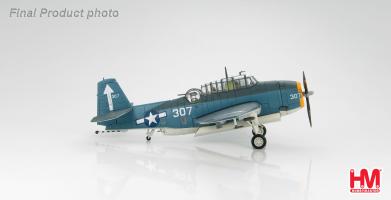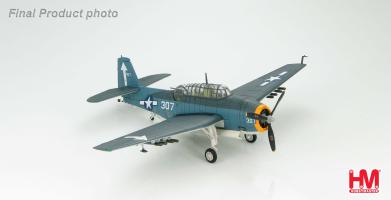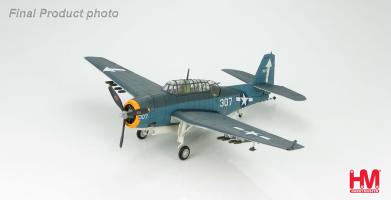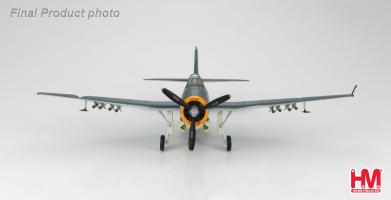Hobby Master Archive
Air Power Propellers 1/72
TBF/TBM
Grumman TBM-3 Avenger VT-84, USS Bunker Hill, April 1945
Hobby Master 1/72 Air Power Series HA1216 Grumman TBM-3 Avenger VT-84, USS Bunker Hill, April 1945
Die-cast metal. Superb detailing in 1/72 scale. Pre-painted with pad applied markings. Fully assembled. Weapons are not permanently attached Bomb bay can be displayed open or closed. Display stand included. Option to display model with wheels up or down. Minimum use of plastic. Very collectable.
Specifications for the Avenger General characteristics - Crew: 3 Dimensions - Length: 40 ft. 11.5 in. (12.48 m) Wingspan: 54 ft. 2 in. (16.51 m) Height: 15 ft. 5 in. (4.70 m) Wing area: 490.02 ft. sq. (45.52 m sq.) Weight - Empty: 10,545 lb. (4,783 kg) Loaded: 17,893 lb. (8,115 kg) Power plant: 1 Wright R-2600-20 radial engine producing 1,900 hp (1,420 kW) Performance - Maximum speed: 276 mph (444km/h) Range: 1,000 miles (1,610 km) Service ceiling: 30,100 ft (9,170 m) Rate of climb: 2,060 ft/min (10.5 m/s) Wing loading: 36.5 ft-lbf sq (178 kg/m sq) Armament - 1x 0.30 cal (7.62 mm) nose-mounted machine gun 2 x 0.50 cal (12.7 mm) wing-mounted machine guns 1 x 0.50 cal (12.7 mm) dorsal-mounted machine gun 1 x 0.30 cal (7.62 mm) ventral-mounted machine gun Up to 2,000 lb (900 kg) of bombs 1 x 2,000 lb (900 kg) torpedo
Just prior to the start of WW II the USN started to look for a replacement for their aging Douglas Devastator. Grumman made a presentation of a prototype labeled as XTBF-1 that impressed the USN and they placed an order to purchase. The plane was perfect for the Navy needs, a huge rotary engine that was enclosed in a barrel like fuselage to cut down on drag, and with some increase in the fuselage and wing lengths would accommodate a three- man crew. Production on what was now officially known as the TBF/TBM Avenger and would come to receive the affectionate name of “The Turkey” from the pilots that flew them began in 1941 with first delivery just in time for the Battle of Midway in June 1942. What started out as a carrier borne torpedo bomber soon turned into a close-support bomber, a patrol aircraft and even a trainer.
On April 7, 1945 the Imperial Japanese Navy set out to inflict as much damage as possible on the American invasion force at Okinawa. Included in the flotilla were the giant battleship Yamato, one light cruiser and 8 destroyers. Aircraft from Task Force 58 had located the armada and tracked it until it came within range of the TBMs from VT-84 “the Wolf Pack” onboard the USS Bunker Hill as well as TBMs and Helldivers from other squadrons. The bombers departed but because of poor visibility were only able to attack a destroyer which they sank. On board the USS Bunker Hill VT-84 was led by veteran pilot Lt. Cdr. Chandler Swanson who instructed his pilots that they were to go after the Yamato, nothing else mattered. Swanson had arranged for 8 of his TBM’s to attack from the port and the remaining 6 to attack from starboard. On the run-in one TBM was shot down and one was badly damaged but continued on his mission. VT-84 had unloaded their torpedoes and claimed 7 torpedoes slammed into the port side and 2 into the starboard. Other groups stood by waiting their turn to attack the 64,000-ton monster. When it was over there had been 19 torpedo hits but when VT-84 returned to USS Bunker Hill they reported the number of hits but that the Yamato and 3 destroyers were still afloat. At 1600 hours word finally came that the Yamato had capsized and exploded.
| Added to archive | 2016-08-01 |
| Last modified | 2016-08-01 |
| Leaflet | 2011-04-01 April 2011 |








